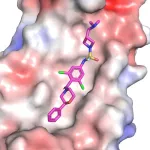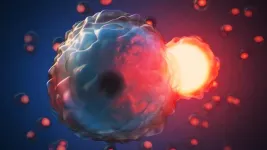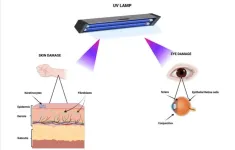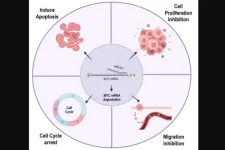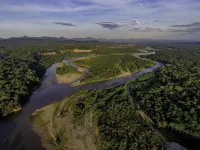(Press-News.org) CLEVELAND - When it comes to skin cancer, most people think of warnings about sunburn and tanning beds. Thoughts of “cancer genes” or inherited risks are reserved for diseases like breast cancer or colon cancer. A new study challenges this status quo by showing that genetics play a larger role in melanoma risk than recognized.
Physicians rarely order genetic screens to assess risk factors for patients with a family history of melanoma because, according to the previous, limited studies, only 2-2.5% of all cases are genetic. For the same reason, insurance companies rarely cover these tests outside of the most extreme situations. In the medical field, genetic testing is generally not offered for cancers that don’t meet a threshold of 5%.
A study from researchers and clinicians led by Cleveland Clinic’s Joshua Arbesman, MD, and Stanford Medicine’s Pauline Funchain, MD (formerly Cleveland Clinic), suggests that melanoma more than meets that threshold. Their results, published in the Journal of the American Academy of Dermatology, report that up to 15% (1 in 7) of patients who received melanoma diagnoses from Cleveland Clinic physicians between 2017 and 2020 carried mutations in cancer susceptibility genes. The research team, which includes Cleveland Clinic Center for Immunotherapy and Precision Oncology’s Ying Ni, PhD, and Claudia Marcela Diaz, PhD, analyzed international patient databases and found similar results.
“Hereditary cancers can wreak havoc through families and leave devastation in their wake. Genetic testing lets us proactively identify, screen and even treat these families to equip them with the tools they need to get the best healthcare possible,” says Dr. Arbesman. “I would recommend physicians and insurance companies expand their criteria when it comes to offering genetic testing to individuals with family histories of melanoma, because inherited predisposition to it isn’t nearly as rare as we think it is.”
Dr. Arbesman, who runs a lab in Cleveland Clinic Lerner Research Institute’s Cancer Biology, also says his findings support an increasingly popular opinion amongst cancer biologists: there are risk factors beyond sun exposure that can influence an individual’s chances of developing melanoma.
“Not all of my patients had inherited mutations that made them more susceptible to the sun,” he says. “There's clearly something more going on here and more research is needed.”
Dr. Arbesman and his team are studying many of the genes that came up in his patients’ genetic tests to learn more about how melanoma develops and how it can be treated. For example, he is working to determine if some of his patients and their families who show inherited mutations may benefit more from immunotherapy compared to those who don't carry inherited mutations. His lab is also working to determine how other patients’ genes contributed to the development and the severity of their melanoma.
END
Inherited genes play a larger role in melanoma risk than previously believed
Up to one in seven melanoma patients are genetically predisposed to the disease, suggesting family history may be a bigger risk factor than sun exposure in some cases
2024-05-21
ELSE PRESS RELEASES FROM THIS DATE:
Two promising UCF researchers earn 2024 NSF CAREER Awards
2024-05-21
Two Promising UCF Researchers Earn 2024 NSF CAREER Awards
Early-career professors Fan Yao and Li Fang are receiving significant research funding to continue catalyzing their work as part of an annual NSF grant program.
By Eddy Duryea ’13
ORLANDO, May 21, 2024 – UCF assistant professors Li Fang and Fan Yao have been named 2024 U.S. National Science Foundation (NSF) Faculty Early Career Development program (CAREER) award winners. The recipients were awarded funding through five years for their submitted projects.
Fang, who is an assistant professor in UCF’s Department of Physics within the College of Sciences, is using the ...
Study comparing U-M Weight Navigation Program with usual care for high-risk patients shows higher use of evidence-based treatments and more weight lost
2024-05-21
Giving high-risk patients access to an obesity specialist through their regular primary care clinic increased their chances of receiving at least one evidence-based weight-management treatment, and led to more weight lost in just a year, a new University of Michigan study finds.
Primary care clinicians commonly struggle to help patients develop an individualized weight-management treatment plan during short clinic visits. Previous U-M research showed that most primary care patients with ...
Stuart Orkin awarded the Shaw Prize in Life Science & Medicine 2024 for groundbreaking hemoglobin research
2024-05-21
[BOSTON, MAY 21, 2024] – Stuart Orkin, MD, a researcher at the Dana-Farber/Boston Children's Cancer and Blood Disorders Center and David G. Nathan Distinguished Professor of Pediatrics at Harvard Medical School, has been honored with The Shaw Prize in Life Science & Medicine for his pioneering work discovering the genetic and molecular mechanisms underlying the switch from fetal to adult hemoglobin. Dr. Orkin shares the prize with Swee Lay Thein, PhD, Senior Investigator and Chief of the Sickle Cell Branch of National Heart, ...
Drug-like inhibitor shows promise in preventing flu
2024-05-21
LA JOLLA, CA—Currently available flu medications only target the virus after it has already established an infection, but what if a drug could prevent infection in the first place? Now, scientists at Scripps Research and the Albert Einstein College of Medicine have designed drug-like molecules to do just that, by thwarting the first stage of influenza infection.
The drug-like inhibitors block the virus from entering the body’s respiratory cells—specifically, they target hemagglutinin, a protein on the surface of type A influenza viruses. The findings, published in the Proceedings of the National Academy of Sciences ...
Study finds widespread ‘cell cannibalism,’ related phenomena across tree of life
2024-05-21
In a new review paper, Carlo Maley and Arizona State University colleagues describe cell-in-cell phenomena in which one cell engulfs and sometimes consumes another. The study shows that cases of this behavior, including cell cannibalism, are widespread across the tree of life.
The findings challenge the common perception that cell-in-cell events are largely restricted to cancer cells. Rather, these events appear to be common across diverse organisms, from single-celled amoebas to complex multicellular animals.
The widespread occurrence of such interactions in non-cancer cells suggests that these events are not inherently "selfish" or "cancerous" ...
Germicidal lamps using UV-C radiation may pose health safety issues
2024-05-21
“Despite the potential advantages of utilizing UV-C radiation for deactivating pathogens such as SARS-CoV-2, the prevailing conclusion remains that UV-C radiation poses concurrent risks to human health.”
BUFFALO, NY- May 21, 2024 – A new research paper was published in Aging (listed by MEDLINE/PubMed as "Aging (Albany NY)" and "Aging-US" by Web of Science) Volume 16, Issue 9, entitled, “Germicidal lamps using UV-C radiation may pose health safety issues: a biomolecular analysis of their effects on apoptosis and senescence.”
The battle against the COVID-19 pandemic has spurred a heightened state of vigilance in global healthcare, ...
Inhibitory effect of miR-377 on prostate cancer cells
2024-05-21
“Our research findings suggest that miR-377 could potentially serve as a valuable therapeutic strategy for the treatment of prostate cancer (PCa).”
BUFFALO, NY- May 21, 2024 – A new research paper was published in Genes & Cancer on May 16, 2024, entitled, “Inhibitory effect of miR-377 on the proliferative and invasive behaviors of prostate cancer cells through the modulation of MYC mRNA via its interaction with BCL-2/Bax, PTEN, and CDK4.”
The MYC gene is a regulatory and proto-oncogenic gene that is overexpressed in the majority of prostate cancers (PCa). Numerous studies have indicated that aberrant expression of microRNAs is involved in the ...
Innovative imaging technique may revolutionize ureteral thermal injury detection
2024-05-21
In a groundbreaking study, scientists have explored a novel approach to detect electrothermal ureteral injuries, a common complication during pelvic surgery. The ureters, delicate tubes that transport urine from the kidneys to the bladder, are particularly vulnerable due to their proximity to other anatomical structures. Unfortunately, current detection methods often fall short in promptly identifying subtle thermal injuries, which can take days or even weeks to manifest.
Enter optical coherence tomography ...
Conservation of nature’s strongholds needed to halt biodiversity loss
2024-05-21
To achieve global biodiversity targets, conservationists and governments must prioritize the establishment and effective management of large, interconnected protected areas with high ecological integrity, John G. Robinson from the Wildlife Conservation Society, US, and colleagues argue in an essay publishing May 21st in the open-access journal PLOS Biology.
The Kunming–Montreal Global Biodiversity Framework (GBF), signed at the 2022 Conference of Parties to the UN Convention on Biological Diversity in Montreal, recognized the importance of protecting large areas of natural habitat to maintain the resilience and integrity of ecosystems. To halt biodiversity ...
Body lice may be bigger plague spreaders than previously thought
2024-05-21
A new laboratory study suggests that human body lice are more efficient at transmitting Yersinia pestis, the bacterium that causes plague, than previously thought, supporting the possibility that they may have contributed to past pandemics. David Bland and colleagues at the United States’ National Institute of Allergy and Infectious Diseases present these findings in the open-access journal PLOS Biology on May 21st.
Y. pestis has been the culprit behind numerous pandemics, including the Black Death of the Middle Ages that ...
LAST 30 PRESS RELEASES:
House sparrows in northern Norway can help us save other endangered animals
Crohn's & Colitis Foundation survey reveals more than 1/3 of young adults with IBD face step therapy insurance barriers
Tethered UAV autonomous knotting on environmental structures for transport
Decentralized social media platforms unlock authentic consumer feedback
American Pediatric Society announces Vanderbilt University School of Medicine as host institution for APS Howland Visiting Professor Program
Scientists discover first method to safely back up quantum information
A role for orange pigments in birds and human redheads
Pathways to net-zero greenhouse gas emissions for Southeast Asia
A JBNU–KIMS collaborative study on a cost-effective alloy matches superalloys for power plants and energy infrastructure
New study overturns long-held model of how plants coordinate immune responses.
New AI model predicts disease risk while you sleep
Scientists discover molecular ‘reshuffle’ and crack an 80-year-old conundrum
How stressors during pregnancy impact the developing fetal brain
Electrons lag behind the nucleus
From fungi to brain cells: one scientist's winding path reveals how epigenomics shapes neural destiny
Schizophrenia and osteoporosis share 195 genetic loci, highlighting unexpected biological bridges between brain and bone
Schizophrenia-linked genetic variant renders key brain receptor completely unresponsive to both natural and therapeutic compounds
Innovative review reveals overlooked complexity in cellular energy sensor's dual roles in Alzheimer's disease
Autism research reframed: Why heterogeneity is the data, not the noise
Brazil's genetic treasure trove: supercentenarians reveal secrets of extreme human longevity
The (metabolic) cost of life
CFRI special issue call for papers: New Frontiers in Sustainable Finance
HKU Engineering scholar demonstrates the smallest all-printed infrared photodetectors to date
Precision empowerment for brain "eavesdropping": CAS team develops triple-electrode integrated functional electrode for simultaneous monitoring of neural signals and chemical transmitters during sleep
Single-capillary endothelial dysfunction resolved by optoacoustic mesoscopy
HKU three research projects named among ‘Top 10 Innovation & Technology News in Hong Kong 2025’ showcasing excellence in research and technology transfer
NLRSeek: A reannotation-based pipeline for mining missing NLR genes in sequenced genomes
A strand and whole genome duplication–aware collinear gene identification tool
Light storage in light cages: A revolutionary approach to on-chip quantum memories
Point spread function decoupling in computational fluorescence microscopy
[Press-News.org] Inherited genes play a larger role in melanoma risk than previously believedUp to one in seven melanoma patients are genetically predisposed to the disease, suggesting family history may be a bigger risk factor than sun exposure in some cases
